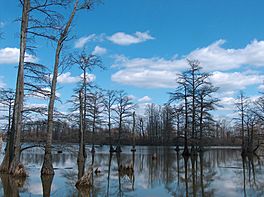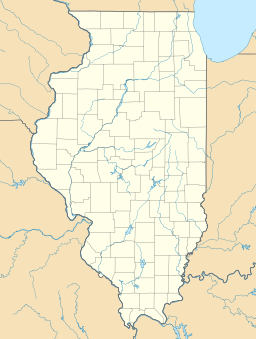Horseshoe Lake (Alexander County, Illinois) facts for kids
Quick facts for kids Horseshoe Lake |
|
|---|---|
 |
|
| Location | Alexander County, Illinois, U.S. |
| Coordinates | 37°08′56″N 089°21′18″W / 37.14889°N 89.35500°W |
| Type | Oxbow lake |
| Basin countries | United States |
| Surface elevation | 322 ft (98 m) |
| Designated: | 1972 |
Horseshoe Lake is a special lake in Alexander County, Illinois. It's known as an oxbow lake. This means it used to be a bend in a river that got cut off.
Today, Horseshoe Lake is part of the Horseshoe Lake State Fish and Wildlife Area. This is a large state park, about 10,645 acres (43.08 km2) big. The lake is shallow and sits near Cairo, at the very southern tip of Illinois. In 1972, the Horseshoe Lake Nature Preserve was named a National Natural Landmark. This means it's a very important natural place in the United States.
What is an Oxbow Lake?
An oxbow lake forms when a river changes its path. Rivers often curve and bend. Over time, a big loop in the river can get cut off. This happens when the river finds a straighter way to flow. The old loop then becomes a separate, U-shaped lake. This is why it's called an "oxbow" lake, because it looks like the U-shaped collar used on an ox.
Challenges at Horseshoe Lake
Horseshoe Lake faces some challenges. One big problem is siltation. This means a lot of mud and dirt (silt) gets carried into the lake. This makes the lake shallower over time.
During the Great Flood of 1993, the nearby Mississippi River flooded. The river tried to flow back into the old bend that is now Horseshoe Lake. But after the flood, the river went back to its usual path.
Because of the silt and its shallow nature, much of Horseshoe Lake looks like a swamp or bayou. These are wetlands with slow-moving water and lots of trees.
Unique Trees and Plants
Horseshoe Lake is a special place for certain trees. It's one of the most northern places where you can find Bald cypress and Tupelo trees growing naturally. These trees usually grow in warmer, southern areas. You can see them along the lake's shoreline.
Another tree found here is the swamp cottonwood. There are also many beautiful American lotus flowers growing in the water. These plants make the lake a unique and important habitat.



